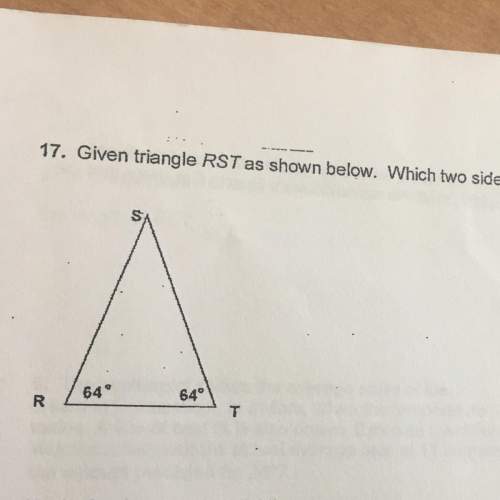
Mathematics, 20.12.2019 05:31 jailynleffel8
Suppose that your company has just developed a new screening test for a disease and you are in charge of testing its validity and feasibility. you decide to evaluate the test on 1000 individuals and compare the results of the new test to the gold standard. you know the prevalence of disease in your population is 30%.the screening test gave a positive result for 292 individuals.285 of these individuals actually had the disease on the basis of the gold standard determination.
calculate the sensitivity of the new screening test.
95.0% 97.6% 99.0% 96.9%
how would you interpret the results of the sensitivity calculation.
of those who tested positive, 97.6% actually have disease the test is able to detect 95% of those with disease the test is able to correctly classify(as negative) 99.0% of those without disease of those who tested positive, 95.0% actually have disease
calculate the specificity of the new screening test.
95.0% 97.6% 99.0% 96.9%
how would you interpret the results of the specificity calculation.
of those who tested positive, 97.6% actually have disease the test is able to detect 95% of those with disease the test is able to correctly classify(as negative) 99.0% of those without disease of those who tested positive, 95.0% actually have disease
calculate the predictive value of a positive test.
95.0% 97.6% 99.0% 96.9%
how would you interpret the results of the predictive value positive calculation.
of those who tested positive, 95.0% actually have disease the test is able to detect 95% of those with disease the test is able to correctly classify(as negative) 99.0% of those without disease of those who tested positive, 97.6% actually have disease
what would happen to the predictive value positive if this test were administered in a population with a disease prevalence of 1% instead of 30%? (note that the sensitivity and specificity of the test remain the same.) would it remain the same? increase? decrease?
predictive value positive would decrease. predictive value positive would increase predictive value positive would remain unchanged

Answers: 3


Another question on Mathematics

Mathematics, 21.06.2019 14:00
Which graph represents the solution of the inequality?
Answers: 1

Mathematics, 21.06.2019 17:00
Mary beth used the mapping rule to find the coordinates of a point that had been rotated 90° counterclockwise around the origin. examine the steps to determine whether she made an error. m (3, –6) is rotated 90° counterclockwise. (x, y) → (–y, x) 1. switch the x- and y-coordinates: (6, –3) 2. multiply the new x-coordinate by –1: (6(–1), –3) 3. simplify: (–6, –3) .
Answers: 1

Mathematics, 21.06.2019 19:30
You have learned about the six trigonometric functions, their definitions, how to use them, and how to represent them graphically. the sine, cosine, and tangent trigonometric functions can be paired with their reciprocal functions, cosecant, secant, and cotangent, respectively. think about how each function is related to its reciprocal function.how are the graphs of the reciprocal functions related to their corresponding original functions? what happens to the graphs of the reciprocal functions as x approaches the zeros of the original functions? describe how you would teach friends with different learning styles (visual-spatial, aural-auditory, verbal-linguistic, physical-bodily-kinesthetic, logical-mathematical, social-interpersonal, and solitary-intrapersonal) how to graph the reciprocal functions
Answers: 2

Mathematics, 21.06.2019 21:50
The value of the expression 16-^3/4 8 1/8 -6 6 1/40 1/64
Answers: 1
You know the right answer?
Suppose that your company has just developed a new screening test for a disease and you are in charg...
Questions


History, 20.10.2019 21:30


Mathematics, 20.10.2019 21:30

Mathematics, 20.10.2019 21:30

Mathematics, 20.10.2019 21:30

History, 20.10.2019 21:30


Social Studies, 20.10.2019 21:30

English, 20.10.2019 21:30


History, 20.10.2019 21:30




Mathematics, 20.10.2019 21:30








